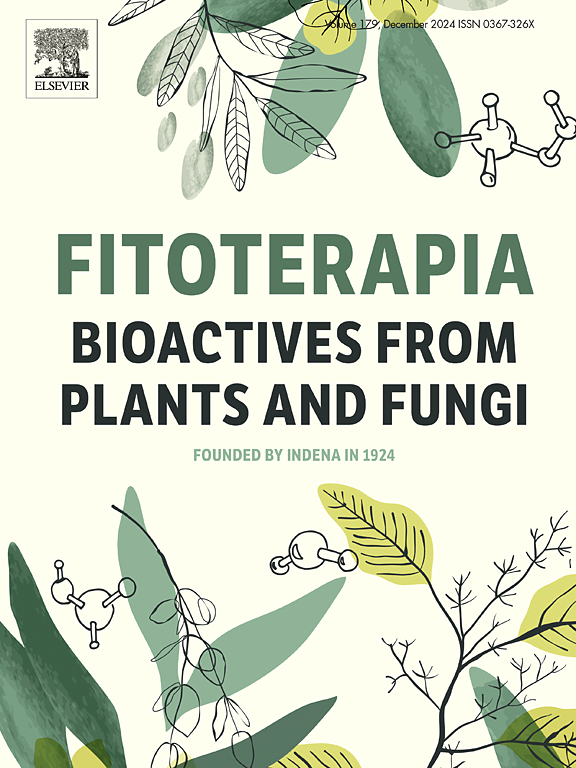In vivo and in silico investigations of flavonoids from Rhamnus alaternus L. in mitigating ethanol-induced oxidative stress and inflammation
IF 2.6
3区 医学
Q3 CHEMISTRY, MEDICINAL
引用次数: 0
Abstract
To investigate the protective effects of Rhamnus alaternus L. against ethanol-induced toxicity, female Wistar rats were divided into 3 groups of 8 rats: control, ethanol (4 g/kg - 40 %), and ethanol with total oligomer flavonoids (TOF) (5 mg/kg). Various parameters, including biochemical and oxidative stress markers, histopathological damage, reactive oxygen species (ROS), nitric oxide (NO) and lysosomal activity in peritoneal macrophages, and cytokine levels, were evaluated after 4 weeks of treatment. Our study demonstrated that ethanol induced a considerable disruption of hematological indices, an increased level of biochemical markers, and MDA level with decreased antioxidant enzyme activities. Furthermore, an increase in ROS, NO levels, lysosomal activity and a significant increase in cytokines levels, indicated inflammation. TOF, however, restored normal levels of hematological indices, biochemical, antioxidant enzymes, and cytokines, and improved histological anomalies. TOF was found to protect rats from ethanol-induced damage owing to its antioxidant and anti-inflammatory properties. In addition, molecular docking simulations of the identified phytocompounds against ‘superoxide dismutase (pdb:4A7G)’ and ‘glutathione peroxidase 1 (pdb:2F8A)’ were performed. Significant results are obtained especially with ‘Kaempferol-3-O-rutinoside’.

鼠李黄酮减轻乙醇诱导的氧化应激和炎症的体内和体外研究
为了研究大鼠黄酮对乙醇毒性的保护作用,将雌性Wistar大鼠分为3组,每组8只,分别为对照组、乙醇组(4 g/kg ~ 40%)和含总低聚物黄酮(TOF)的乙醇组(5 mg/kg)。治疗4周后,测定各组大鼠腹膜巨噬细胞的生化和氧化应激标志物、组织病理学损伤、活性氧(ROS)、一氧化氮(NO)和溶酶体活性以及细胞因子水平。我们的研究表明,乙醇引起血液学指标的严重破坏,生化指标水平升高,MDA水平降低,抗氧化酶活性降低。此外,ROS、NO水平、溶酶体活性的增加和细胞因子水平的显著增加表明炎症。然而,TOF恢复血液学指标、生化、抗氧化酶和细胞因子的正常水平,并改善组织学异常。由于其抗氧化和抗炎的特性,TOF被发现可以保护大鼠免受乙醇引起的损伤。此外,对鉴定的植物化合物进行了抗“超氧化物歧化酶(pdb:4A7G)”和“谷胱甘肽过氧化物酶1 (pdb:2F8A)”的分子对接模拟。得到了显著的结果,特别是山奈酚-3- o -芦丁苷。
本文章由计算机程序翻译,如有差异,请以英文原文为准。
求助全文
约1分钟内获得全文
求助全文
来源期刊

Fitoterapia
医学-药学
CiteScore
5.80
自引率
2.90%
发文量
198
审稿时长
1.5 months
期刊介绍:
Fitoterapia is a Journal dedicated to medicinal plants and to bioactive natural products of plant origin. It publishes original contributions in seven major areas:
1. Characterization of active ingredients of medicinal plants
2. Development of standardization method for bioactive plant extracts and natural products
3. Identification of bioactivity in plant extracts
4. Identification of targets and mechanism of activity of plant extracts
5. Production and genomic characterization of medicinal plants biomass
6. Chemistry and biochemistry of bioactive natural products of plant origin
7. Critical reviews of the historical, clinical and legal status of medicinal plants, and accounts on topical issues.
 求助内容:
求助内容: 应助结果提醒方式:
应助结果提醒方式:


